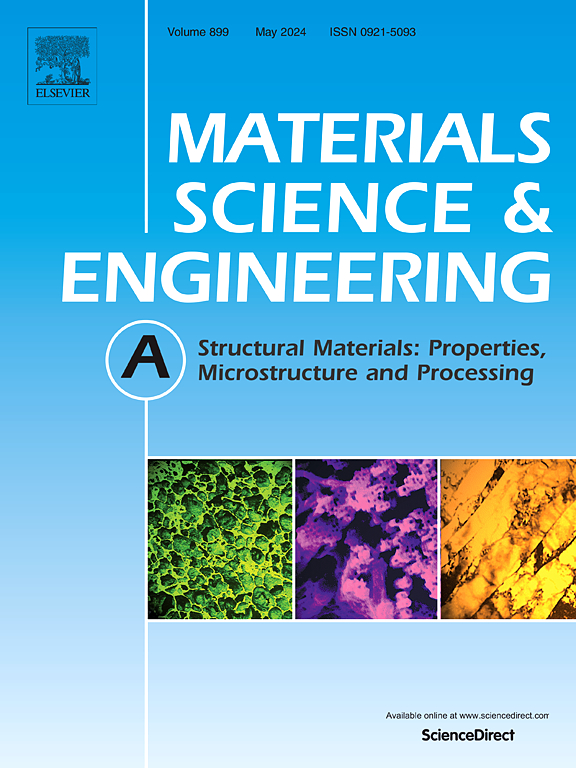Influence of cooling rate on the evolution of γˈ precipitates in a low-density CoNi-base γ/γ′ superalloy
IF 7
2区 材料科学
Q1 MATERIALS SCIENCE, MULTIDISCIPLINARY
引用次数: 0
Abstract
The mechanical properties of γ/γʹ superalloys are governed by the size, shape, and distribution of the γʹ precipitates within the γ matrix. This work explores the feasibility of microstructure tuning by varying cooling rates in a low mass density γ/γ′ Co-30Ni-10Al-2Nb-4Ti-12Cr (at %) superalloy. We observe a strong cooling rate dependence on the morphology, composition, shape, and size distribution of γ′ precipitates. Cooling rates ≥6.25 K/s from super-solvus temperature (1413 K) of the alloy show unimodal size distribution of γˈ precipitates with a high number density. Whereas a slower rate of cooling (≤6.25 K/s) results in the formation of the bimodal size distribution of γˈ precipitates. For all the cooling rates explored (100, 28, 6.25, 1.625, 0.43, and 0.108 K/s), secondary γˈ precipitates exhibit nearly cuboidal morphology, and power law describes the evolution of their size with different cooling rates. Atomic-scale compositional analysis by an atom probe reveals the composition of secondary γˈ precipitates is dependent on the cooling rates. In addition, we found finer tertiary γˈ precipitates near the secondary γˈ precipitates and matrix interface, while relatively larger tertiary γˈ precipitates away from the secondary γˈ precipitates for the slow cooling rates (1.625 K/s, and 0.108 K/s). This was attributed to the concentration gradient that develops in the γ matrix region in between the secondary γʹ precipitates during continuous cooling. In the light of classical nucleation theory, the results indicate a multi-stage formation of γˈ precipitates whose morphology, size distribution, and composition are found to be dependent on the cooling rates. Hence, these experiments shows the possibility of tuning the microstructure of Co-based superalloys that is critical in governing their mechanical properties.
冷却速率对低密度coni基γ/γ′高温合金γ/γ′析出相演化的影响
γ/γ′高温合金的力学性能与γ′析出相的大小、形状和分布有关。本研究探讨了在低质量密度γ/γ′Co-30Ni-10Al-2Nb-4Ti-12Cr (at %)高温合金中通过改变冷却速率进行微观组织调谐的可行性。我们观察到冷却速率与γ′析出相的形貌、组成、形状和尺寸分布密切相关。在超溶剂温度(1413 K)下,冷却速率≥6.25 K/s时,合金的γ δ析出相呈单峰尺寸分布,且数量密度较高。而当冷却速度较慢(≤6.25 K/s)时,γ δ析出相的尺寸呈双峰分布。所有的冷却速率探索(100年,28岁的6.25,1.625,0.43,和0.108 K / s),二级γˈ沉淀展览几乎立方形的形态,和幂律描述了进化的大小不同的冷却率。原子探针的原子尺度成分分析表明,二次γ α沉淀的组成依赖于冷却速率。此外,在二次γ δ δ析出相和基体界面附近发现了细小的叔γ δ δ析出相,而在缓慢冷却速率(1.625 K/s和0.108 K/s)下,远离二次γ δ δ析出相的叔γ δ δ析出相相对较大。这是由于在连续冷却过程中,在二次γ′沉淀之间的γ基体区域中形成的浓度梯度。根据经典形核理论,研究结果表明,γ γ沉淀是多阶段形成的,其形貌、尺寸分布和组成与冷却速率有关。因此,这些实验显示了调整co基高温合金微观结构的可能性,这对控制其机械性能至关重要。
本文章由计算机程序翻译,如有差异,请以英文原文为准。
求助全文
约1分钟内获得全文
求助全文
来源期刊

Materials Science and Engineering: A
工程技术-材料科学:综合
CiteScore
11.50
自引率
15.60%
发文量
1811
审稿时长
31 days
期刊介绍:
Materials Science and Engineering A provides an international medium for the publication of theoretical and experimental studies related to the load-bearing capacity of materials as influenced by their basic properties, processing history, microstructure and operating environment. Appropriate submissions to Materials Science and Engineering A should include scientific and/or engineering factors which affect the microstructure - strength relationships of materials and report the changes to mechanical behavior.
 求助内容:
求助内容: 应助结果提醒方式:
应助结果提醒方式:


